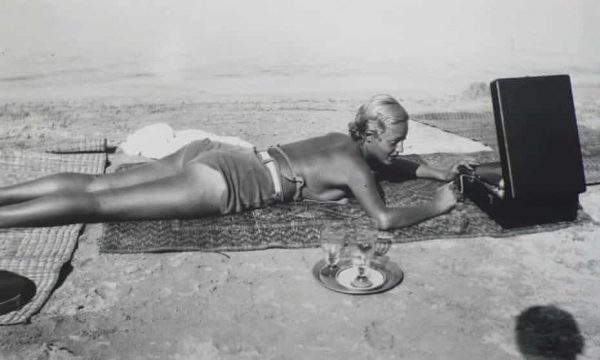Tan Lines Matter

^
When you go on your summer vacation
You go to Juan-les-Pins
With your carefully designed topless swimsuit
You get an even suntan on your back and on your legs
And when the snow falls you’re found in St. Moritz
With the others of the jet-set…
But where do you go to, my lovely
When you’re alone in your bed?
Won’t you tell me the thoughts that surround you?
Tan lines did indeed matter: brown patch, sun-burned soldiers, farm labourers, fishermen, coachmen, seamen, stevedores – all were marked as déclassé, members of the great unwashed. The pallid nobs, the bigwigs, followed shadows, hid beneath parasols, sat in their sunless parlours and clubs, and, if deemed necessary by fashion, applied Venetian ceruse, an ultra-poisonous whitener of lead salts – take another look at Queen Elizabeth I.A little later, skin bleaching with mercury became a vogue with even more drastic effect.
The phenomenal population growth of the late 18th century, and the urgent surge of demand for labour during the Industrial Revolution, created a massive new proletariat. A farm-fresh influx of peasants was packed into tall tenements on narrow streets steeped in perpetual and polluted gloom. The multi-generational working families became distinguished by the pallor of the “dark satanic mills”.
Along with the filthy murk came a plague of hideous deformities known as Morbum Anglorum – rickets.
Unlike the highly infectious, mainly urban, faecal borne diseases such as typhoid, cholera, dysentery, hepatitis A and poliomyelitis, rickets only occasionally killed infants, and very many “rickety” kids survived to become excruciatingly incapacitated dwarves with contorted spines and limbs, with bowed or knock-knees, and by debilitating muscle weakness.
Although a remote Polish physician had rumbled that lack of sunlight was responsible for rickets in 1822, his thesis was simply not believed for a further 70 years. Sadly, by 1900, it was estimated that 80% of the children living in the industrialised cities of Europe and America were afflicted with this devastating disease. (1)
Today, the annual incidence in the UK of rickets in under 16-year-old children is around 0.48 per 100,000, “serious complications and unexpected death… mainly occurring in Black and South Asian under 5 years”. (2)
I do not expect Tobias Smollett rings many bells today, but, in mid-eighteenth-century England, this deeply satirical Scottish author had the country by the ear. Of course, he had to be a doctor, and had set off in 1763 to France and Italy on his “Travels”, partly in an attempt to cure his chronic chest infection, partly to take the piss out of insalubrious foreigners. Smollett succeeded on both counts, and his “Travels” soon became a huge best seller, rather curiously causing rustic Provence, and in particular Nice, to become the winter health resort of choice for the wealthy elite. Members of the Holy Trinity Anglican Church of Nice soon funded a seaside walkway – Le Promenade des Anglais.
Yet another Scottish doctor, John Brown, preached “climatotherapy” as a cure for tuberculosis, resulting in an ever-increasing colony of expatriate invalids. According to a French observer, Nice was filled with “pale and listless English women and listless sons of nobility near death”. Well, I suppose the balm and fragrance of the Côte d’Azure, the Riviera, made a refreshing change from the sulphurous fumes and irritating tittle-tattle of Bath and Tunbridge Wells.
The arrival of the railway in 1864 created the first wave of tourists and the onslaught of artists – name one and he was there – soaking up the colour, the light and the wine.
“Coco” Chanel, the chicest of all whores, happened by in 1918, liked the Riviera, and returned in 1927 with the Duke of Westminster’s swag and a successful fashion business to take up residence. The influx of California-wise Americans, Scott Fitzgerald et al, and the influence of Chanel’s summertime boutique beach gear magicked an overstuffed Victorian winter destination into a hedonist’s seventh heaven – shortly to be the home base of the atome, the “bikini”.
“So where do you go to, Marie-Claire?” – to Juan-les-Pins, bien sûr.
During the Second World War, the occupying Italian and German servicemen revelled in the luxurious safe zone of the Riviera. The National Socialist League of the Reich for Physical Exercise, the NSRL, took charge, pursuing the Nazi ideals of Aryan superiority and control by Kraft durch Freude, “Strength through Joy”.
When we returned in 1946, the art of ne rien faire of the ‘20s and ‘30s had been somewhat gingered by the new ski nautique, the ubiquitous beach ball, snorkelling, serious swimming and sandy PT lessons.
To be bronzé and svelte was firmly established as the new marker for health and wealth; it was no longer smart to be pale and interesting, and a paunch no longer pulled.
In Britain, wartime food rationing, Government’s firm control over diet, and mandatory vitamin D supplementation of milk and margarine, had largely eliminated rickets, had reduced infant mortality rates, and had increased life expectancy. Obesity with associated diabetes had become unusual.
The two World Wars of the 20th century created a massive demand for high calorie, low volume, long-life food — rations for the many millions of troops strewn over every continent. The international food processing industries soon started to generate profits to match those of the munition manufacturers. Which would have been the better investment – Nestlé or Krups?
Post-war, processed food fast became a commodity to be traded ruthlessly for maximum profit at minimum cost. The “Big Food” corporations produced foods “designed to be convenient, eaten on the go, hyperpalatable and appealing to the consumer”, using the cheapest possible ingredients.
The first McDonalds opened in the 1940s, and by 1958, a single franchise in Des Plaines, Illinois had sold its 100 millionth hamburger. Pizza Hut, Domino’s, Kentucky Fried Chicken and Dunkin Donuts came up quickly from behind. The fast-food boom was here to stay.
The scarcity of food prior to the 19th century had led to the connotation that being fat was good, as we have seen. By the early 20th century, obesity was firmly established as a risk factor for mortality from diabetes, high blood pressure and heart disease. After the Second World War, reduced physical activity in conjunction with an inappropriate calorie consumption triggered the start of the obesity epidemic (3).
Vitamin D deficiency is closely associated with obesity, probably through dilution in fat, body fluids and the liver. Loss of visceral fat, the paunch, reverses the deficiency (4). Vitamin D importantly modulates the efficacy of the immune system, and deficiency of vitamin D gives rise to increased susceptibility to infection (5), especially acute respiratory infection. There is insufficient vitamin D in food to satisfy the body’s demands. Exposure of the skin to sufficient UVB radiation (as in sunlight) is necessary for adequate vitamin D production: other causes can be skin pigmentation, clothing, and sunblock (6).
And so, our not-so-dotty Scottish doctors of the 18th century have been proved to have been on the right track. We Brits should not be deprived of our sunshine holidays.
Sadly, we now know that the obesity epidemic and its consequences, inclusive of lack of vitamin D, have helped to give rise to our truly terrible COVID death toll.
“Governments now recognise the overwhelming industrial developments that guarantee an escalating (obesity) epidemic but neither they nor WHO know how to engage in changing the societal framework to promote routine spontaneous physical exercise and a transformation of the food system so that low energy-density food of high nutrient quality becomes the norm” (7).
The 2020 Global Obesity Forum declaration published its ROOTS framework in March 2021:
Recognise that obesity is a disease
Obesity monitoring and surveillance must be enhanced
Obesity prevention strategies must be developed
Treatment of obesity should be accessible to all
Systems based approaches should be applied to the treatment and prevention of obesity.
References:
- PMID 20046581 Shining light on the vitamin D: Cancer connection IARC report
- PMID 31949032 Nutritional rickets under 16 years: UK surveillance results
- PMID 17045228 A history of obesity, or how what was good became ugly and then bad
- PMID 31466220 Vitamin D Deficiency: Consequence or Cause of Obesity?
- PMID 21527855 Vitamin D and the immune system
- PMID 27589793 Seasonal Changes in Vitamin D-Effective UVB Availability in Europe and Associations with Population Serum 25-Hydroxyvitamin D
- PMID 19136980 WHO recognition of the global obesity epidemic
Falstaff:
“Thou seest I have more flesh than another man and therefore more frailty.”
“The repercussions of how fat is represented in this play, therefore can be analysed in light of Ato Quayson’s aesthetic nervousness and Mitchell and Snyder’s narrative prosthesis. Because encounters with disability in real life can constitute junctures of crisis and self-reflection for normates who are suddenly confronted with the contingencies of their own able-bodiedness and the moral dilemma of how to behave during such interactions, people often mentally overwrite the encountered body with a simplistic, ableist paradigm.”
OK?
*crip – a disabled person (offensive. North American), or an LA offshoot of the Black Panthers (they carried offensive walking sticks)


